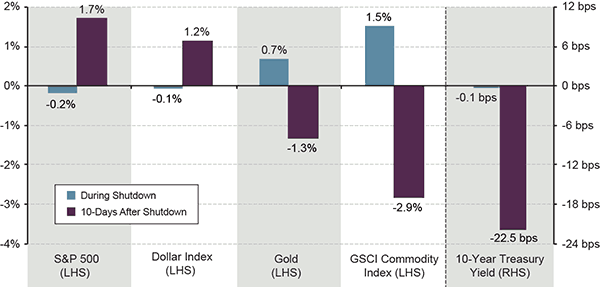Volatility from the government shutdown and other political developments in Washington D.C. will likely continue to rise. Despite this, the reduction in output from this will be short-term, and investors still have several attractive options for deploying capital across asset classes in the United States and globally.
The U.S. government has shut down 17 times since 1976, but the current brinksmanship unfolding in Washington has the potential to last longer and have a more pronounced effect on markets than previous examples. Uncertainty over the drama on Capitol Hill is leading to higher volatility, but weakness in asset prices likely represents a buying opportunity. There are also favorable investment options outside of the United States, which will benefit from ongoing loose monetary conditions.
There is little incentive for either the Democrats or Republicans to agree to a budget deal before October 17th, the forecasted date when the debt ceiling will need to be raised. Because the U.S. government is no longer spending, there is also a chance that this date could move further out on the horizon. The consensus estimate is that each week of the shutdown will reduce 4Q GDP by 25 basis points, meaning that fourth quarter growth could be up to 75 basis points lower by the time the shutdown is over. This is especially significant given that the expectation for 4Q GDP is only currently around 2.5 percent.
Having said this, there is no risk that the U.S. Treasury will default in the coming weeks. Importantly, these political headwinds represent relatively isolated shocks to GDP, and their effects will likely recede fairly quickly given the torque in the underlying economy. Leading indicators show no sign of a recession, and a resurgence in output growth could still occur during the first half of 2014.
There are a number of ways for investors to take advantage of the political dysfunction in Washington. Historically, equities rally when uncertainty over a shutdown begins to subside, so there is a case for buying stocks, which have fallen in seven out of the last nine sessions. Stifled growth also means that interest rates have further room to leg down, which is supportive of fixed income assets. Finally, there are abundant opportunities for excess returns outside of the U.S. right now, with both European and emerging market equities offering attractive valuations and improving fundamental outlooks.
Gauging the Impact of Government Shutdowns
There have been 17 U.S. federal government shutdowns since 1976. Excluding drastic moves in commodity prices and bond yields in the late 1970s, analysis of eight occasions during the past 30 years reveals that U.S. equities and the dollar tend to decline during shutdown periods, while gold and commodities tend to perform well. Shutdown periods do not appear to have a significant effect on 10-year Treasury yields. Historically, when a shutdown ends, market performance reverses quickly, and Treasury yields fall by an average of 22 basis points over the following 10 days.
The economic impact of a shutdown largely depends on its duration. According to consensus estimates, a week-long shutdown would cut annualized GDP growth by approximately 25 basis points in the fourth quarter.
AVERAGE PERFORMANCE OF SELECTED ASSETS DURING GOVERNMENT SHUTDOWN PERIODS (1983 - PRESENT)

Source: Bloomberg, Guggenheim Investments. Data as of 9/30/2013.
This material is distributed for informational purposes only and should not be considered as investing advice or a recommendation of any particular security, strategy or investment product. This article contains opinions of the author but not necessarily those of Guggenheim Partners or its subsidiaries. The author’s opinions are subject to change without notice. Forward looking statements, estimates, and certain information contained herein are based upon proprietary and non-proprietary research and other sources. Information contained herein has been obtained from sources believed to be reliable, but are not assured as to accuracy. No part of this article may be reproduced in any form, or referred to in any other publication, without express written permission of Guggenheim Partners, LLC. ©2013, Guggenheim Partners. Past performance is not indicative of future results. There is neither representation nor warranty as to the current accuracy of, nor liability for, decisions based on such information. Past performance is not indicative of future results. There is neither representation nor warranty as to the current accuracy of, nor liability for, decisions based on such information.





